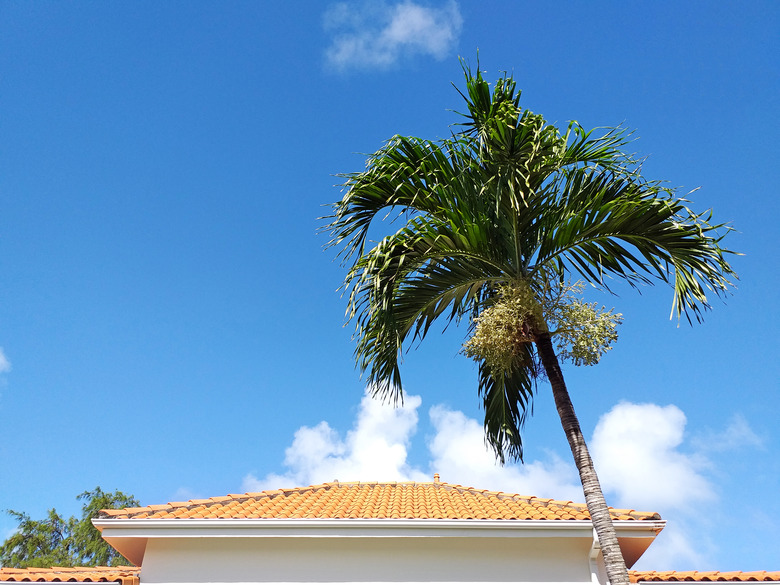How To Cure Sick Palm Trees
Sick palm trees (family Arecaceae or Palmae) can have a variety of issues, from nutritional deficiencies to fungal diseases. Nursing your palm tree back to health starts with figuring out the root cause and correcting those issues. That can be relatively easy if the issue is lack of certain nutrients, but it becomes more difficult if you're dealing with diseases, which often have no cure.
Palm Tree Care Issues
Palm Tree Care Issues
Overwatering causes yellow or brown leaves that fall off prematurely. This can happen if you water too much or the soil doesn't drain well. If you aren't watering your palm tree enough, the leaf tips tend to turn brown and dry. Water your palm trees when the top 2 inches of soil are dry, or use a moisture gauge to help figure out when to water.
Too much fertilizer can cause leaves to turn yellow. Back off on the fertilizer if you suspect this is the issue. Using a slow-release fertilizer that's specifically formulated for palms in early spring and midsummer is usually enough for palm trees.
Excessive pruning can also cause issues for palm trees. Cutting palm fronds prematurely, even if they're browning, can take energy away from the tree. Pruning requirements vary by species, but it's usually best to wait until the frond is fully brown or falls to a 90-degree angle before pruning.
Palm Tree Nutritional Deficiencies
Palm Tree Nutritional Deficiencies
Performing a soil test to determine nutritional deficiencies is the key to diagnosing nutritional deficiencies; second-guessing doesn't work. Potassium deficiencies cause translucent yellow, orange or bronze spots along the sharp edges of palm leaves, usually starting with older foliage. Slow-release potassium sulfate applied with slow-release magnesium can correct the issue while maintaining the proper potassium and magnesium balance. This can also help with a magnesium deficiency, which shows up as a lemon-yellow band on the margins and green centers on older foliage.
Manganese deficiencies can kill your palm tree if not corrected. High soil pH levels, above 6.5, make manganese insoluble. Manganese deficiency shows up as yellowing between veins and as necrotic streaking between veins on newer leaves. Eventually, new leaves look withered or scorched and are often smaller than normal. Adjusting the soil pH to lower it can help and so can applying manganese sulfate at a rate of 1 teaspoon for every gallon of water applied to the palm tree's soil two or three times yearly.
Iron deficiencies can cause yellowing in newer leaves followed by brown leaf tips if it progresses. This often happens when the soil is too compact or your palm tree was planted too deep, so correcting those issues is the most effective approach. You can also apply a chelated iron fertilizer according to the package instructions. Nitrogen deficiencies usually aren't an issue since palm trees don't need much, but uniformly light green, smaller foliage can be a sign of this deficiency. Applying slow-release, nitrogen-containing fertilizer according to package instructions can correct this issue.
Palm Tree Diseases
Palm Tree Diseases
Several palm diseases can kill your trees, and many don't have a cure. If a palm tree dies from a fungal disease, get rid of all plant material, sanitize your pruning equipment and avoid planting new palms in the same spot since the pathogens often survive in soil. Ganoderma butt rot is a severe fungal disease that causes the trunk's interior to rot and, eventually, the head to fall off or the trunk to collapse. First signs include drooping or withering of older fronds. No treatments exist for this disease.
Bud rot is another fungal disease that usually kills the palm tree. It causes black spots on buds and new fronds, eventually killing all of the foliage and leaving just the trunk. If your tree is exposed to the pathogens, applying fungicide regularly to new growth might stop the fungus from taking hold.
Leaf spot fungal diseases often happen when palm leaves stay wet, resulting in elongated, brown spots on the foliage. It doesn't typically kill the tree, but if the damage becomes severe, you might need to apply a copper fungicide, which is safe for fruit-growing palm trees. Keeping palm tree foliage dry can also help.
